ALL...ABOARD!: Contoocook Depot
Introduction
Text-to-speech Audio
Images
In 1884, the Contoocook rail center consisted of the following buildings: the depot and ell, freight house, engine house, water house, wood shed, three hand car houses, and rail shop. All of these structures, with the exception of the depot and freight house, had been removed by 1904. Since then, the freight house has also been removed. This 1892 Sanborn Insurance Map shows the location of these structures.
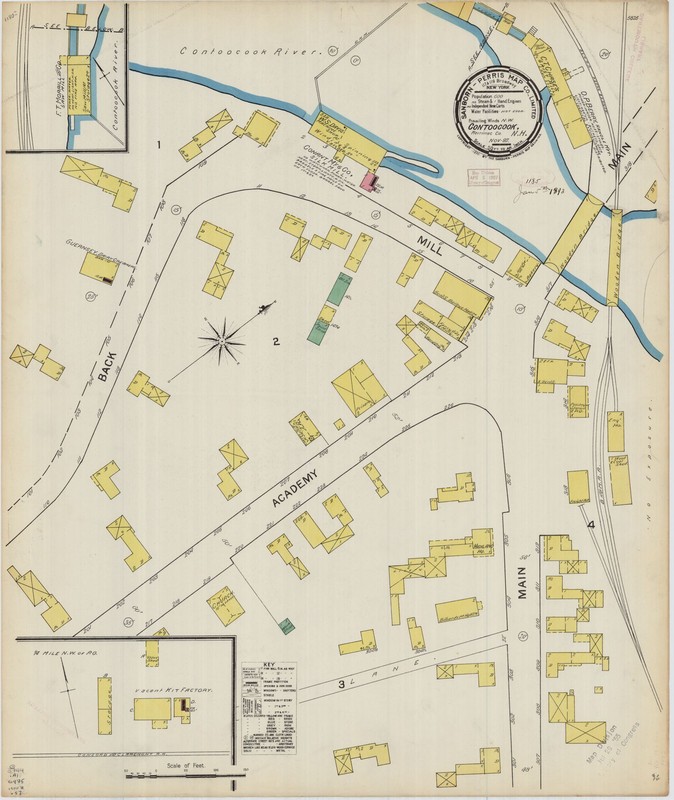
Providing an enjoyable travelling experience for its passengers was important to the Boston & Maine Railroad, which sponsored flower competitions at depots. Shown here is a display of flowers at the Contoocook Depot.
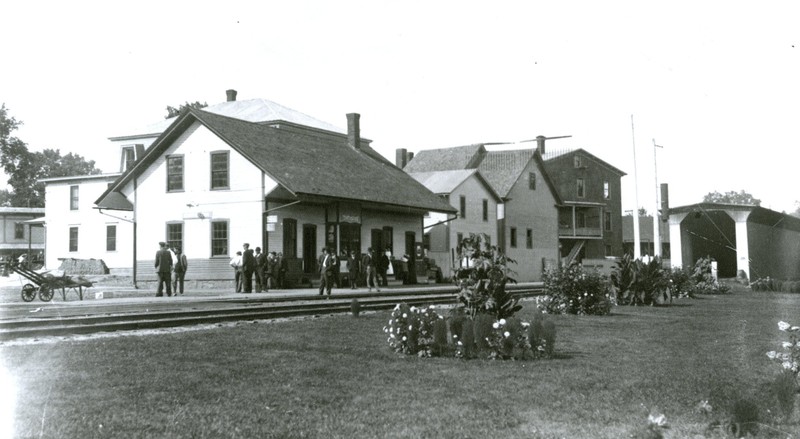
This undated photograph shows the Depot on the right, in about the middle of the photo. Just beyond the Depot is the freight house.
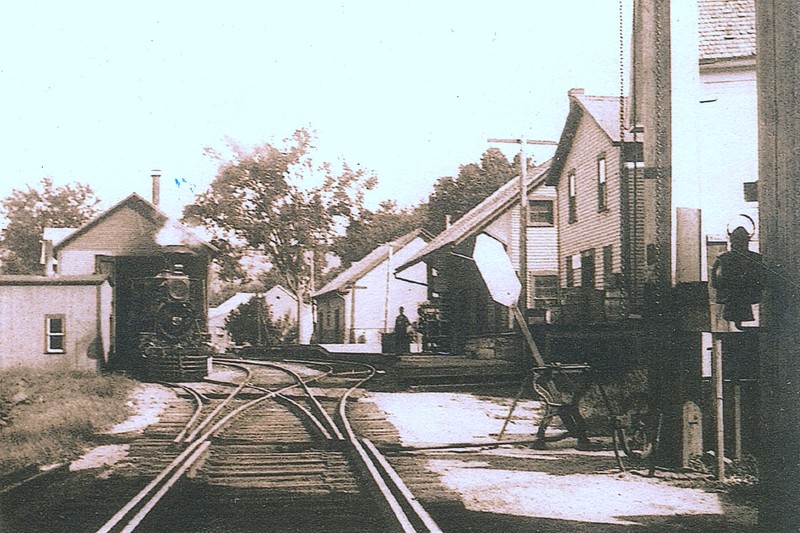
Image of the interior of the Contoocook Depot following restoration.
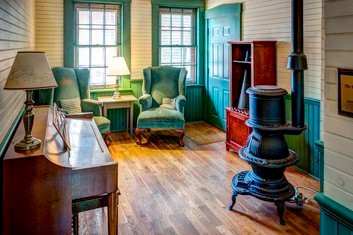
Image of the exterior of the Contoocook Depot following restoration.
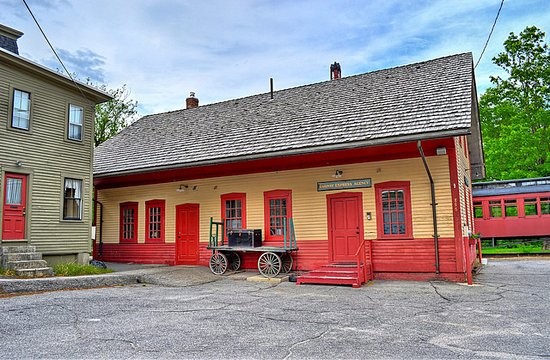
Lovely image of six young people at the Contoocook Depot with the covered railroad bridge visible on the right. Perhaps they were preparing to embark for a trip to the city? Hand-written on the reverse “Alice Fifield Richard Clough James Purrington Allice True (I think) Almond Corliss (I think)” No indication is given as to the order of names or individuals. However, Allice Fifield, Richard Clough, and James Purrington were all 1912 graduates of Hopkinton High School, and the males served in WWI. Although the photo is not dated, it was likely taken sometime between graduation in 1912 and the U.S.’s entry into WWI in 1918.
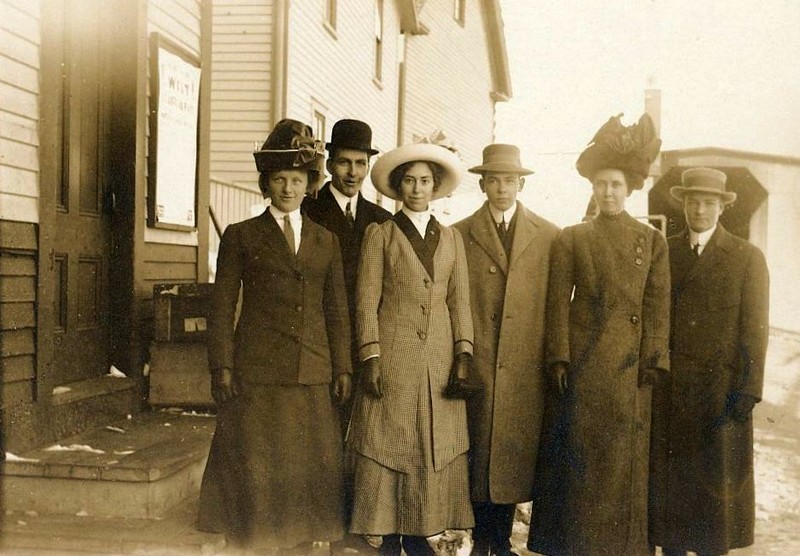
Image of what is believed to be the Tramp House that was located near the Contoocook Depot. The tramp house was located where the Contoocook Riverway Park is located today. The shoreline in the image does not match up with the shoreline today due to changes in the flow of the Contoocook River following construction of the Hopkinton-Everett Dam.
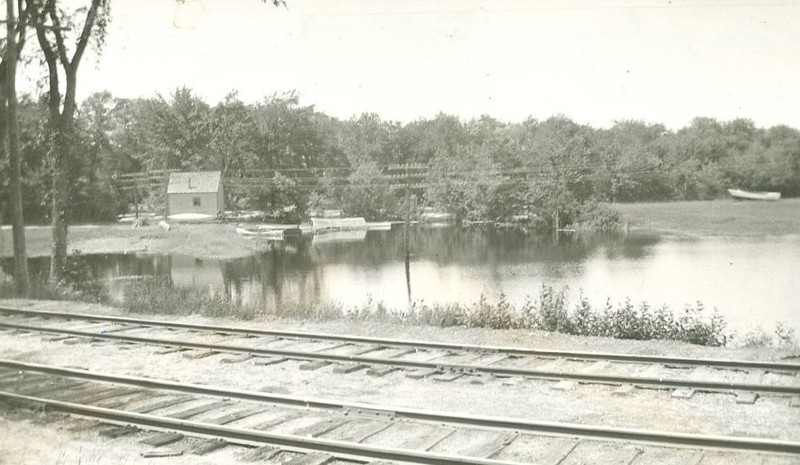
Joe Cornett (1912-1996) of Hopkinton spent time riding the rails as a young man.

Dan Dustin reading Joe Cornett's oral history compiled by Craig Bohanan.
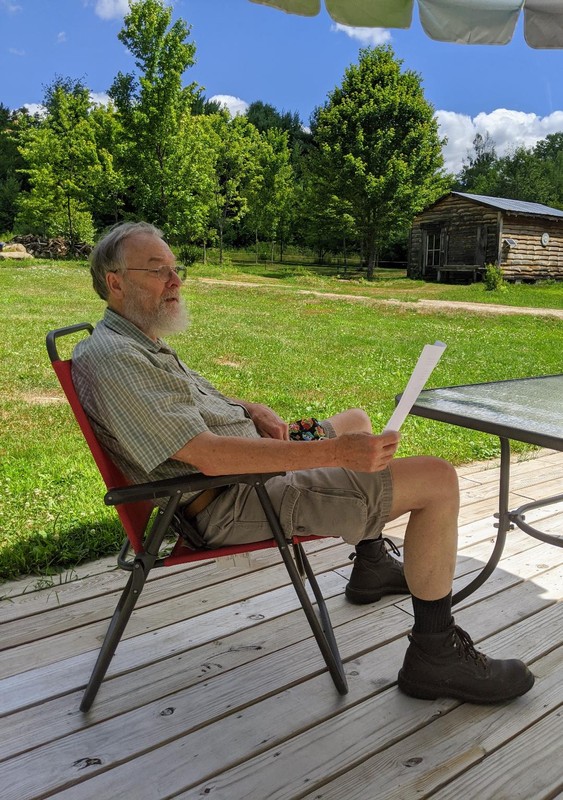
Newly repainted Contoocook Covered Railroad Bridge.
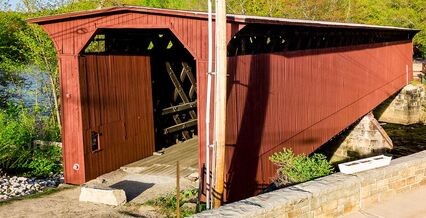
The historical marker for the Contoocook Depot and Covered Railroad Bridge.
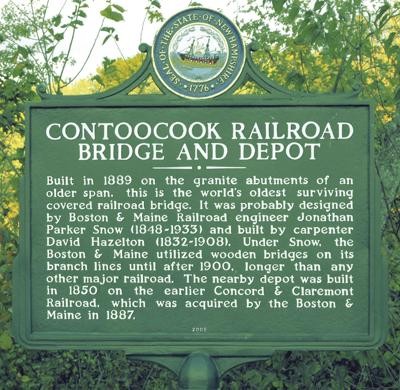
Image of the covered railroad bridge in Contoocook during high waters.
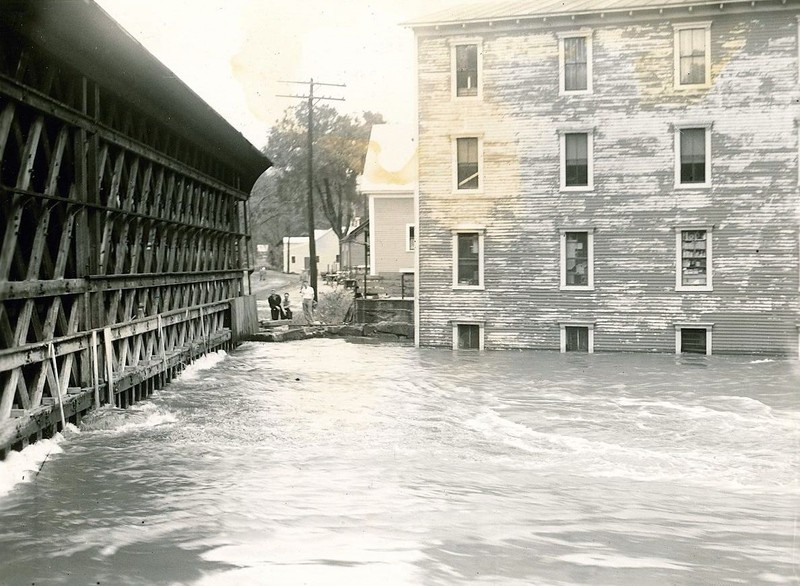
Image of the covered railroad bridge in Contoocook during high waters.
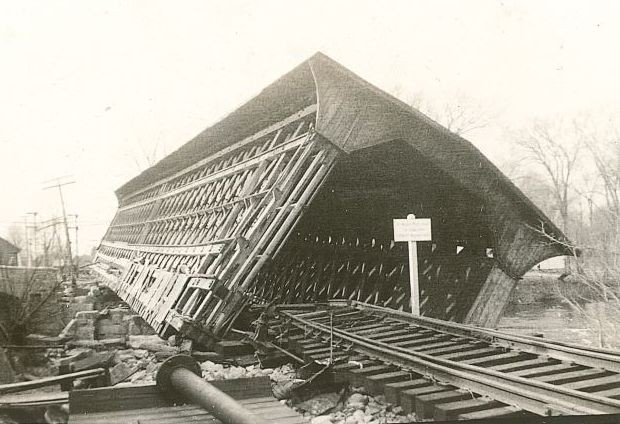
Image of the covered railroad bridge in Contoocook after it was tipped during the 1938 hurricane.
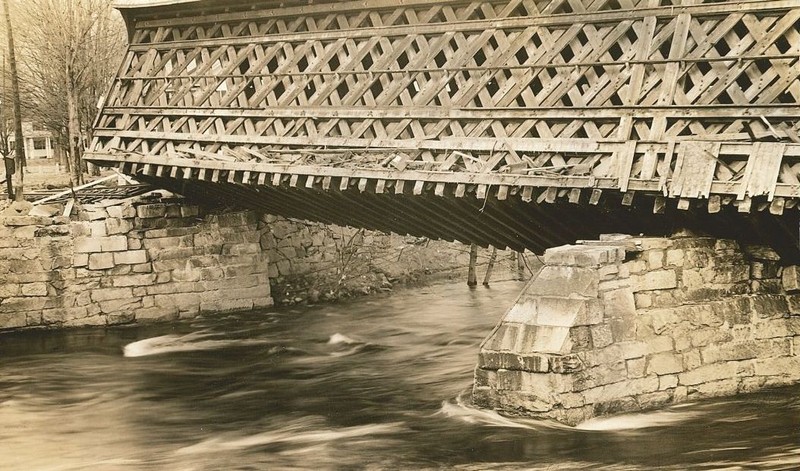
Seen here through the covered highway bridge (which was replaced with the stone highway bridge in 1935), is the Old Central House, a boarding house where a group of Irishmen who helped build Contoocook’s railroads boarded. Today it is the site of Mr. Mike’s gas station.
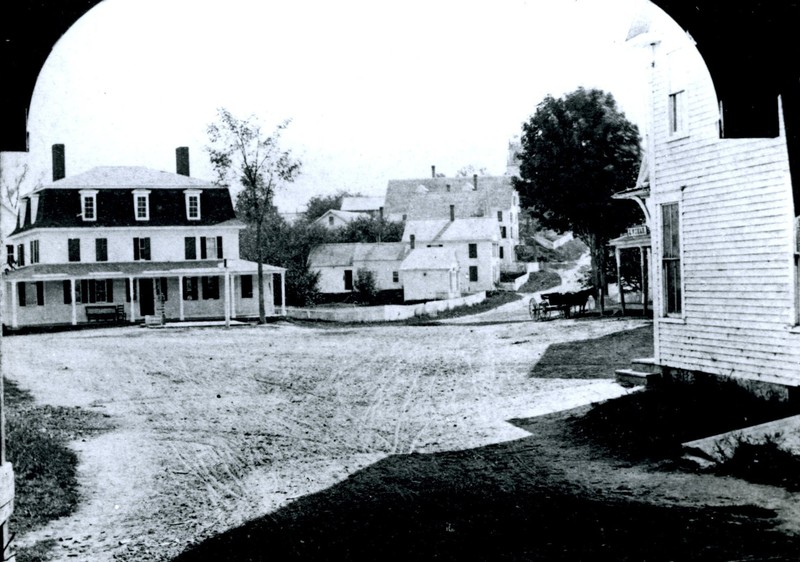
Section gang photo. One of the two men in the center not holding any tools is likely the foreman. The man on the left is holding a spike maul that is used to hammer spikes into the ties. The man second from the right (Theodore Mack of Webster) is holding a spike puller, a long tool with a forked end used for removing spikes.
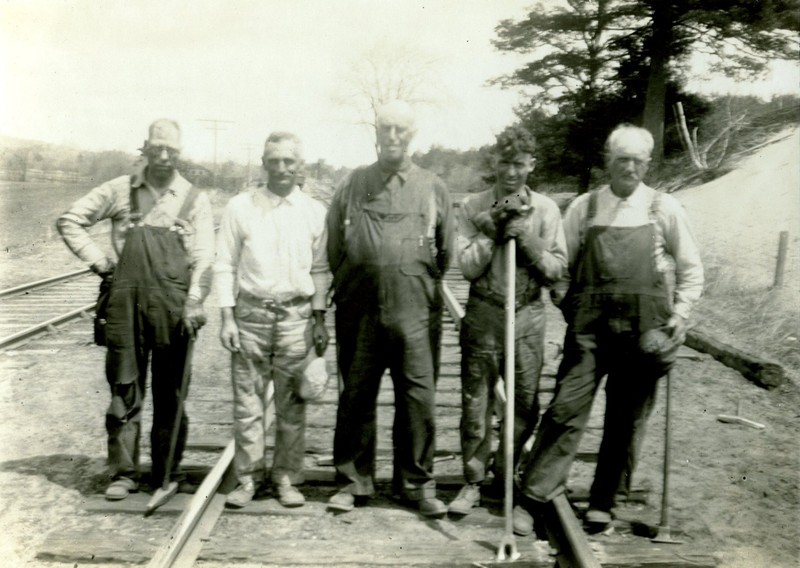
A set of railroad reports from the 1870s-1880s uncovered interesting information about local labor relations.
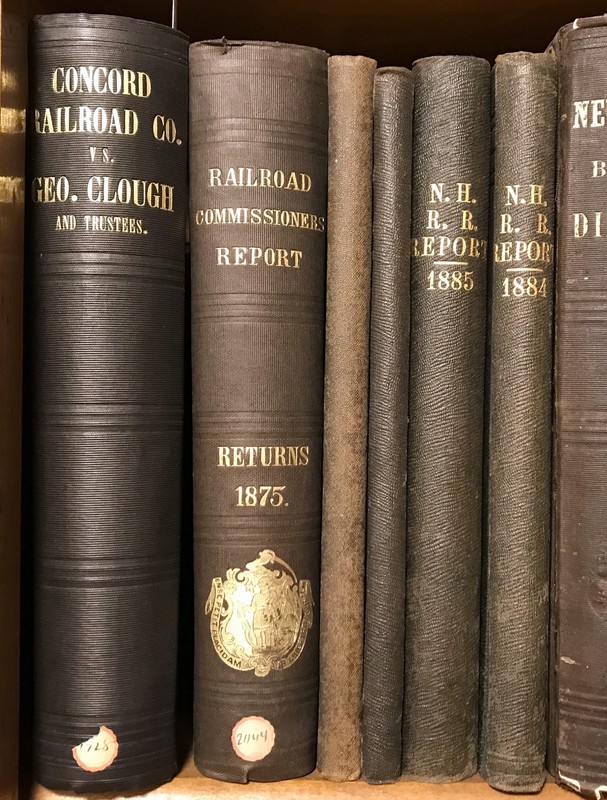
Members of the N.H. Legislature received free passes to ride the railroad. William Eaton Chandler, in his 1891 book commonly known as “Book of Bargains,” claimed that railroads “corruptly govern New Hampshire” through the use of railroad passes and railroad money.
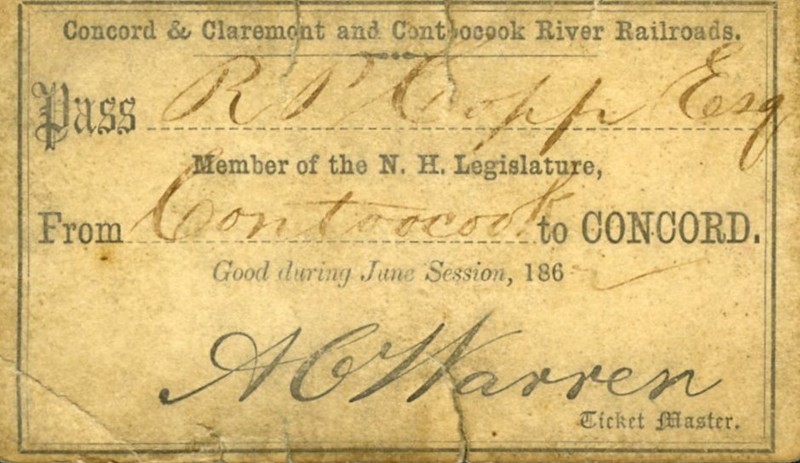
Still image of Forrest Gillingham taken from film by Oscar Polhemus, circa 1930.
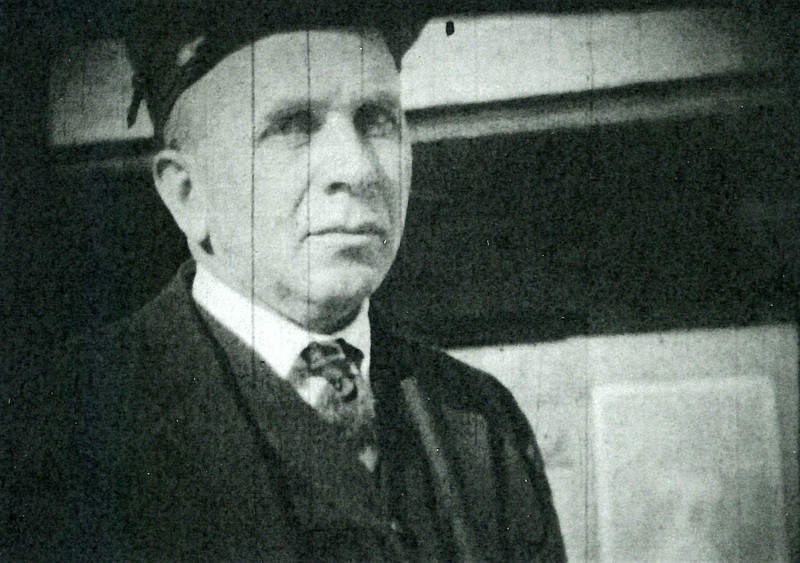
Still image of Forrest Gillingham taken from film by Oscar Polhemus, circa 1930.
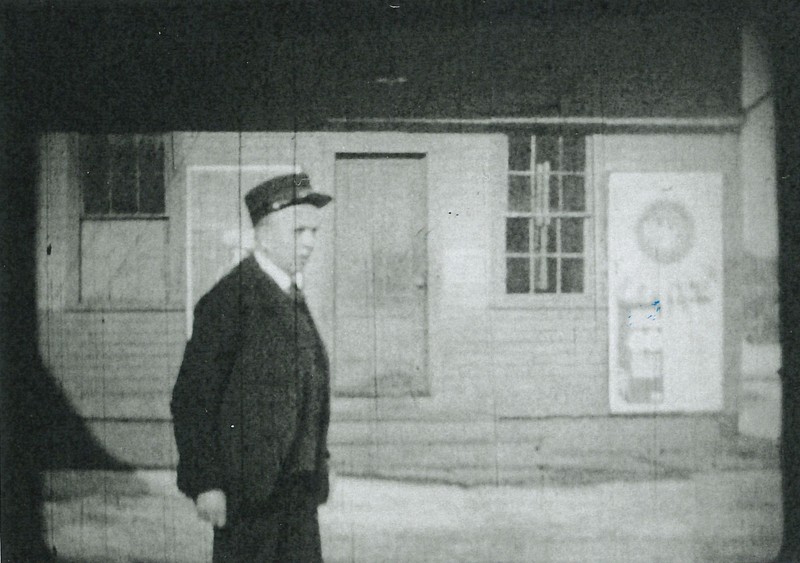
Photograph of Ken Smart (left) and Jim Dalby (right) at the Contoocook Depot, c. 1950.
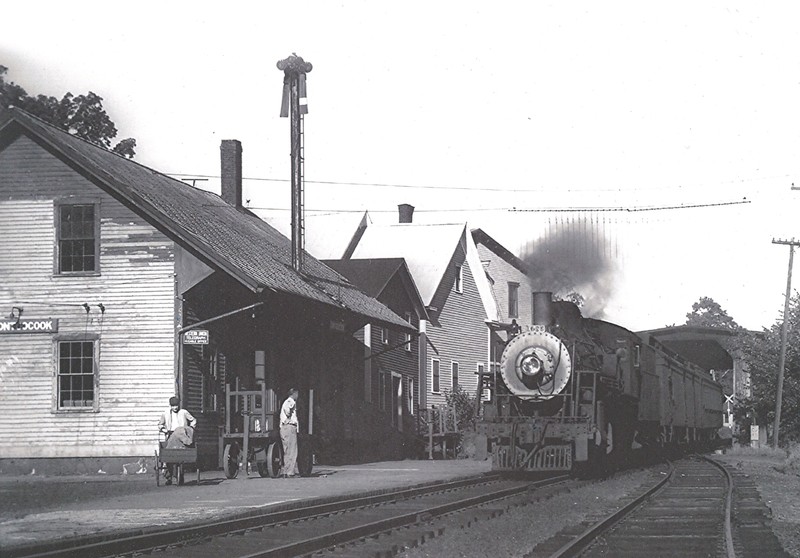
Backstory and Context
Author-Uploaded Audio
Hopkinton resident Dan Dustin reads the oral history of Joe Cornett compiled by Craig Bohanan.
Text-to-speech Audio
"In the fall of 1849, when the first train travelled between Concord and Contoocook, a day of great festivity was held. Railroad officials extended free rides to and from the city of Concord, and a large celebration was held. A subscription had been raised, a public dinner provided, music and artillery secured, and about 1,000 people sat down to eat at the long tables that had been set up. Speeches were made, the band played, and the cannon thundered."
from Life & Times in Hopkinton by C.C. Lord
In the 1950s, as the era of railroad transportation in New Hampshire was waning, the Depot was purchased by Dodd Insurance Agency, which it shared with the railroad until 1956. That year auto-bus routes took over mail transportation, and passenger service from Contoocook to Concord was given up. In 1962, when the Hoague-Sprague mills in West Hopkinton converted from coal (delivered by rail from Claremont to West Hopkinton via Contoocook) to oil (delivered by truck), freight service was discontinued.
In 1999, the Depot was purchased by the Contoocook Riverway Association from the town of Hopkinton for one silver dollar and restoration began in 2002. The $400,000 restoration project was funded by federal grants community donations and took approximately three years to complete.
The depot's surviving interior details include two ticket windows and most of the original walls and ceilings, still covered with tongue-and-groove paneling common in the late 19th century. Over the years, many original items have been returned to the depot by the community such as the enameled blue "Contoocook" station sign, luggage cart, seating bench, and other irreplaceable items.
Go to Contoocook Railroad Museum for additional details about current and future restoration projects.
TRAMP HOUSES
On March 12, 1878, Hopkinton voters authorized up to $200 to be spent on building two tramp houses, one in each village. The town report of 1879 indicates a prompt response with payments to various individuals for lumber, labor, nails, Blacksmith work, bedding, and rent of land for “tramp’s house.” This expenditure was most likely in response to a large increase in numbers of itinerants occurring locally and nationwide, many being Civil War veterans who, for various reasons, found themselves unable or uninterested in returning to their previous homes and lifestyles. The nation’s economy was in shambles and many of these men were looking for some way to scratch out an existence. Many were rail-borne, some getting work building and maintaining the country’s ever-expanding system of railroads and others riding the rails to short-term jobs in fields and factories, near and far away. With each succeeding down-turn in the economy, the number of transients nationwide would temporarily increase, especially leading up to WWI and again during the Great Depression, at which time it is said that more than a million men, as well as women and children, became American hoboes.
Most hoboes were honest people who simply wanted to find decent jobs. They gathered in camps known as “jungles,” usually located on the sunny side of hills for warmth, with trees and brush for shelter and a source of water for drinking, bathing, and washing their clothes, and within walking distance of railroad tracks. They often shared a meal, such as a “mulligan stew,” made by boiling water and adding scraps of meat and vegetables, each person contributing whatever he might have. Hoboes would always clean their camp area before moving on. They did not steal from each other, although gangs of robbers targeted hoboes on known pay days. Hoboes formed a loose brotherhood and developed a code of symbols, sometimes engraved on fence posts, to indicate matters of survival such as where food, meals, or a place to sleep might be offered, where work was available, where medical help might be found, and where dogs or police officers hung out.
As is human nature, the itinerants themselves developed a hierarchy with the label “hobo” indicating superiority, one who works hard and moves quickly, “tramp” meaning one who loafs and walks, and “bum” defining one who loafs and sits. It is certain that hoboes boarding a moving train (once it was out of the range of the railroad police) and riding it safely (sometimes lying on rods underneath a boxcar) demonstrated strength, skill, initiative, and resilience, traits that many employers might value highly. In fact, the hoboes among us have included such highly successful individuals as TV host Art Linkletter, oil tycoon H.L. Hunt, writer Carl Sandburg, and Supreme Court Justice William O. Douglas.
Here in Hopkinton, the two tramp houses offered itinerants shelter over many decades, with various repairs recorded as late as 1934. A town Tramp Department existed in the early 1900’s to assure help for tramps. The 1914 town report shows that Oscar N. Chase had been paid $45.00 for the care of 180 tramps and Frank H. Mills had been paid $40.25 for the care of 161 tramps. Taxpayers paid an additional $19.50 for wood and $4.00 for bedding while H. P Wilson was paid $2.00 for rent of the land for the tramp house. The 1915 town report included an article for the town meeting, “To see what action the town will take in relation to tramps, and pass any vote relating thereto.” The statistics recorded in that annual report included Oscar N. Chase being paid $87.50 for the care of 350 tramps and Frank H. Mills being paid $61.25 for the care of 245 tramps. Costs for wood, quilts, food, coffee, and rent had brought the Tramp Department expenditures to a total of $205.25. By 1918, the town report no longer showed a Tramp Department but rather oversight of tramps under the Police Department (with Oscar N. Chase and Frank H. Mills continuing to be involved). Starting in 1918, the town property list included “tramp house and cage” and these continue to be listed through the 1920’s; starting in 1930, more generic terms such as “town hall, lands, and buildings” replaced specific listings. After 1946, care of tramps is no longer mentioned in town reports.
Recently (March 11, 2020), Fritz Wetherbee on WMUR’s Chronicle, told about tramps and tramp houses in New Hampshire. Although tramps were prevalent in his childhood, Fritz said he hadn’t seen a tramp for about 60 years. Most of the tramps he knew had regular routes, passing through town at the same time each year; townspeople often looked forward to seeing them. Many New Hampshire towns once had tramp houses, but he knows of only three that remain standing, located in Richmond, Dunbarton, and Weare. Showing the small nicely repaired and restored one in Richmond, he reported that they usually contained a pallet to sleep on and a small woodstove, being a place to get out of the elements.
In speaking with current and recent residents of Hopkinton, only a few remember glimpses into this era of the town’s history. One recalls that her mother had told her to come right in from playing outside if a man looking a little different came around. Another remembers seeing tramps near the stream by his family home on Main Street but they didn’t approach and he didn’t fear them. A man who worked daily at the railroad station during his high school years (late 1940’s/early 1950’s) did not see any tramps riding the trains; a classmate who also worked occasionally at the station remembers seeing tramps in the area at times but they didn’t engage socially; he had been brought up to respect tramps and never thought ill of them. He also recalled a local resident who had once lived as a tramp and had written of his many fascinating adventures. Another man recalled that his mother would offer food and clothing to a few of the tramps and that the same tramps would return periodically; they were quiet, neither friendly nor frightening to him although he said that many townspeople were afraid of them. He also admitted to hitching a few rides on the rail himself as a youth, actually being given a hand to board by the conductor as the train slowed for Spring Street; he would go visit an aunt in Melvin Mills, or, with a buddy, enjoy a day in Warner, coming home by same day return train. Memories of life in Little Tooky in the 1940’s were shared by one of the ladies who lived there for many years. Although she questioned their wisdom, some of the women who lived by the River all summer, while their husbands worked out-of-state during weekdays, provided meals for some of the tramps coming into town. Perhaps if one searched the area even today, the code for “good for a handout” or “kind women” might be found with directional arrows faintly tooled on a fence post near the location of the Contoocook tramp encampment.
Joe Cornett
While it is unlikely that Hopkinton's Joe Cornett spent any nights at the Tramp House in Contoocook, we are including his story here as part of the larger story of increased transience during periods of economic downturn.
During the Great Depression, it is estimated more than a quarter of a million teens left their homes in search of a job, a better life, and perhaps an adventure. Two such young men were Joe Cornett (1912-1996) and Howard Keats of Hopkinton. They decided to head to California when they were both about 18 years old. Joe ended up travelling for about six months before returning home to Hopkinton. His story is part of an oral history compiled by Craig Bohanan.
There was a kid named Howard Keats, 17 or 18 years old — around my age — lived down in Hopkinton on the main road towards Concord; wanted someone to go to California with him. He didn’t have much money and I didn’t either — had about $55.
We started in summertime. We took some food with us, we took blankets and we took junk. First day or two I thought: what the hell am I doing here? But about the third day we were sleeping on the side of the road and the sun came up and it was a lovely day and from then on in the trip was okay. Near the Continental Divide the damn car broke down — we put a connecting rod through the crankcase. Anyway, we got this car all put back together and finally got to Venice, California where Howard’s mother was living. This was during the Depression so it was very difficult to get work. We’d mow lawns for a quarter and went up to Culver City to try to get work at Metro-Goldwyn; get work at a labor job. You had to have a hammer — you couldn’t get a job without a hammer. Had to have it for knocking sets apart or something. I never did get a job there.
Finally what happened was a kid named Johnny Krause who came from Sheboygan, Wisconsin — Johnny wanted to go home and it was suggested I go with him. Howard says: “I don’t think you ought to go, Joe.” But I decided to. So we started out next morning bumming down the highway to Indio, California, a railroad town. We found the jungle, the hobo camp, and there were maybe 30 kids there. When a train comes by they say “everybody out!” and out we went. We got to a little town in Arizona called Maricopa and there they shook the train down — now shaking a train down is when the brakeman and the railroad dick go down the train and put all the bums off. By the time we got to Tucumcari there’s 29 of us traveling together. 29 of us slept on the jailhouse floor there. A thirtieth came in and had no place to lie down.
Then Johnny wants to go to Chicago to get to Sheboygan, but I want to stay south, because it’s getting cold. So I say goodbye to Johnny and get a train for St. Louis. The car I’m in is all lined with paper so I tear the paper down, wrap myself up in it to try to keep warm, because it’s November or December now, see. In St. Louis they had this place for homeless men called the Helping Mitt. You could go in there, get a bath, get your clothes deloused, see a doctor, get something to eat. You could stay 2-3 days, but I didn’t stay that long.
In East St. Louis around dusk I’m waiting for a train and a police car comes up and the policemen says: “What are you doing there?” I told him I was waiting for a train and he says: “Well, that’s a hell of a place to wait! They’ll kill you for the coat you got on. They shot a man right by that electric light pole a couple of nights ago. You better come up to the station.” Next day I say to myself: I think I’ll try the highway.
I finally got to Indianapolis, then Dayton, and into Wheeling, West Virginia. I went to Harrisburg then across the Hudson and up to Port Jarvis. I went in a diner there. They invite me into the back room and it’s a speakeasy! Place is loaded with guys. This kid takes a suitcase, fills it with bottles of booze, opens a drawer, takes out a revolver and starts filling it with shells. They’re going to run booze into New York along the same route Legs Diamond took before he was shot.
Finally I get into Boston. It was snowing and I had no rubbers and my feet were wet and cold and I got a ride to Lowell. I didn’t want to buy a railroad ticket, but I went down to the station and asked the man what it would cost to get to Concord. He told me and I got enough money — I got 19 cents left over! So I bought the ticket and got into Concord. Rafa Story was there and by Christ he gave me a ride home!
CONTOOCOOK COVERED RAILROAD BRIDGE
The Contoocook Covered Railroad Bridge is the oldest covered railroad bridge in the U.S. still standing. It was rebuilt in 1889 to replace a lighter covered railroad bridge constructed between 1849–50, having been built by the former Concord and Claremont Railroad (acquired by the Boston & Maine Railroad in 1887). It is the oldest of four surviving double-web Town lattice railroad bridges. It was likely designed by Boston & Maine Railroad engineer Jonathan Parker Snow (1848–1933) and built by carpenter David Hazelton (1832–1908). Under Snow, the Boston & Maine utilized wooden bridges on its branch lines longer than any other major railroad, the last of these constructed in 1916. The bridge was in use as a railroad bridge until 1962. It survived a flood in 1936, and the 1938 Hurricane. Both times it was moved off its foundations and saved from being completely washed down river by the rail tracks running through it.
High water was often an issue for the Contoocook Covered Railroad Bridge. During the flood of 1936 and the hurricane of 1938, the bridge suffered extensive damage. In fact, the only thing that prevented the bridge from being carried downriver was the strength of the steel railroad tracks. Following the 1936 flood, the Claremont and Hillsboro Railway lines suffered so much damage that there was talk of discontinuing them. Claremont, however, had just finished paying franchise and demanded that the washed-out bridges, including the damaged bridge at Contoocook, be restored. Following damage from the 1938 hurricane, trains from West Henniker to Hillsboro were given up.
From the NH Division of Historical Resources:
Location: East of N.H. Route 103 in Contoocook Village on the old Concord and Claremont Railroad line spanning the Contoocook River.
Style of Bridge: Double Town-Pratt lattice truss
Year of Construction: Originally constructed in 1849-50 with major reconstruction in 1889.
Original Cost: Unknown
Structural Characteristics: The bridge is 140'1" long and has clear spans of 64'0" and 67'0". It has an overall width of 21'6" and a roadway width of 15'1", and a maximum vertical clearance of 19'4". The rail line has been abandoned.
Maintained By: New Hampshire Division of Historic Resources
World Guide Number: 26-07-07
New Hampshire Number: 10
Historical Remarks: The structure was originally built when the Concord and Claremont Railroad laid its first 33 miles of track from Concord to Bradford, N.H. In the fall of 1850 when trains began to run regularly between Concord and Contoocook, a "day of great festivity" was held. Speeches were made, the band played, and the cannon thundered. A thousand people sat down to eat at a public dinner that cost $200 to put on. The bridge washed off its abutments in 1936 when the Contoocook River flooded and again in 1938 from a hurricane. The bridge was kept from washing downstream because the rails were bolted together at each joint. After the flood water receded, the bridge was drawn back to its location and restored. From 1962 until 1990 a Contoocook merchant owned and used it as a warehouse. In 1990 the bridge was given to the New Hampshire Division of Historic Resources under RSA 234:31. In the National Register of Historic Places Inventory (nomination form) it was stated that this bridge is the oldest covered railroad bridge still standing in the United States. The Railroad Bridge is listed on the National Register of Historic Places.
RAILROAD WORKERS
Railroad Workers: Who Built Hopkinton's Railroads?
Here’s an interesting piece of Contoocook history. Where Mr. Mike’s gas station is now located, once stood a boarding house, called Old Central House. It would later be moved across the street, and for many years would be the Grange Hall and later the Boys & Girls Club. But when it was a boarding house, right across from the train station, there resided a group of Irishmen, who helped build Contoocook’s railroads.
Notes from Contoocook Grange (Hopkinton Historical Society 2014.17.24): “The home of Mrs. Edith Krzyzaniak and our grange hall was situated in Contoocook Square where the Esso station and Johnson Insurance Stands. It was built in 1831 and owned by Nathaniel G. H. Morrill. It was called Old Central House. A family of Blodgett and Walcott ran the Central House …. Young Irish men from Ireland boarded there and were Railroad laborers.”
In 1850, the census shows that the band of young Irish men were doing the same work on the Railroad in Bradford, also staying at a boarding house by the railroad. We presume that it was the same group of Irish laborers, following the work further down the line. Several people suggest that many young Irish men came to New Hampshire (and elsewhere) in the late 1840s due to the potato famine in Ireland. Many served as laborers on New Hampshire’s railroads.
Railroad Workers: Snapshot from the 1910 Census
The 1910 census Hopkinton census included nine men that listed their employment as working in some capacity for the railroad. Below is a list of the men, their job titles, and a description of the jobs.
- Laborer: George Sweatt (1850-1927), the laborer, could have been a general laborer in one or more departments, possibly "Bridge and Buildings,” where he might have been an apprentice or just "muscle" at the bottom of the pay scale.
- Section Hands: George W. Bailey (1872-1948), James W. Ripley (1849-1930), Fred True (1866-1935), and Benjamin H. Bartlett (1888-1960) were responsible for the care of the track and right-of-way for a section of the railroad, usually from two to eight miles.
- Fireman: Bert Geer (1888-1976) was most likely a locomotive fireman, subordinate to the engineer on a locomotive and responsible for care of the boiler, maintaining boiler pressure (essential to getting the required amount of power from it), and general assistance in operating the locomotive. He kept it fed with coal fuel and filled with the proper amount of water from the "tender" (the small car behind the locomotive). He would have been responsible for filling the tender with fuel and water when necessary.
- Station Agent & Telegraph Operator: The roles of Forrest Gillingham (1874-1953) and Ernest McLam (1877-1952) were somewhat interchangeable. Operators were essentially for control of traffic (telegraphy and signaling) under the direction of the dispatcher, whereas agents may have those duties and also station duties such as ticket sales, processing of packages and local freight shipments, mail handling, etc.
- Section Foreman: Edward Sweatt (1866-1935) would have been the boss of a section gang.
Railroad Workers: Labor Relations
Railroad labor relations were not always smooth, as evidenced by the 1869 lawsuit of directors vs. conductors.
A set of rarely-used books on the Hopkinton Historical Society’s bookshelf consists of Railroad Reports of the 1870s through 1880s. One book on that shelf caught our attention, titled, “Concord Railroad Co. Vs. Geo. Clough and Trustees.” We were wondering what we could learn about life during the railroad era, who was George Clough, why was there a lawsuit, and why was the book on the Society’s shelf?
Here’s what we learned. George Clough (1817-1895; son of Rachel Clifford & Isiah Clough; husband of Eliza Hardy) was a Railroad conductor, living in Concord, NH, at the time of the 1869 lawsuit where the Board of Directors of Concord Railroad accused him and all the conductors of stealing money from passenger train fares; all of the conductors were summarily fired. The case was tried by John Hatch George (of Concord and Hopkinton; he served on the Board of Directors of Contoocook Valley Railroad, and was attorney for Concord Railroad). A hand-written opinion found in the book reads, “Interesting insight into management operations; the [RR] Line, to cover poor management, fired all the conductors over an illegal ticket transaction which had been authorized by the line superintendent, General B. F. Butler; some of his former officers of the Army of the James were the detectives.” The copy of the book at Hopkinton Historical Society reads, “Compliments of George Clough,” who self-published the entire legal record in order to shed light on the tense relationship between directors and conductors.
Forrest Gillingham, Station Agent
Forrest Gillingham (1874-1953) served as Station Agent at the Contoocook Depot for many years. He is listed as such in the 1910 census; the Society has images of him wearing a Station Agent’s hat in front of the Depot circa 1930; and Ken Smart remembers Mr. Gillingham as the Station Master while he worked for the railroad from 1947-1952.
Station Agents are typically the person in charge of a railway station. Duties might vary from station to station, but generally were responsible for control of traffic (telegraphy and signaling) under the direction of the dispatcher. Their station duties included ticket sales, processing of packages and local freight shipments, mail handling, etc.
Railroad Worker: Ken Smart
I spent many hours at the Depot working for Forrest Gillingham, the station agent at that time. The timeframe would have been starting about 1947 until June 1952. Those were my Junior and Senior High School years.
I met four trains a day, six days a week as usually we had Sunday’s off because the mail did not run on Sunday.
The duties were many but probably the most important was to insure the mail got from the Post Office to the train and back again. Luckily we did not have far to go as the Post office was located where Kerry’s Carpets [190 Pine St, Contoocook, NH] is today. I wonder what became of that three wheel push cart you can see me with in the attached picture?
As I remember the schedule, the first train of the day was around 8:00 am from Claremont and returned at 10:30 am from Concord. I would get out of school to meet the train thanks in part to Bill and Doris Milne, two of the teachers at that time.
The afternoon schedule was 5:00 pm from Claremont and return from Concord around 7:00.
The job of keeping the old coal fired furnace running and the ashes removed was not a lot of fun nor was mopping the hardwood floors that were badly worn in places. But the overall job was a good experience for a teenager at that time even though it required taking a lot of teasing about it from my peers.
I never got to really operate the telegraph key as the speed of the operators on the line was faster than I could keep up with. Mr. Gillingham was quite proficient with the key as that was the main means of communication between train stations at that time.
Portion of a letter written by Ken Smart to the Contoocook Riverway Association during the restoration of the Contoocook Depot
Sources
Bohanan, Craig. Oral history of Joe Cornett.
Chandler, William Eaton. New Hampshire a Slave State: Senator Chandler's Series of Papers Commonly Known as the Book of Bargains. 1891.
Chiles, James R. “Hallelujah, I’m a Bum.” Smithsonian Magazine, July 31, 1998.
Concord Railroad Corporation vs. George Clough and Trustees. Concord, NH. The People Steam Press, 1869.
Contoocook Railroad Museum. Accessed May 15th 2020. https://www.contoocookdepot.org/.
Hix, Lisa. “Don’t Call Them Bums: The Unsung History of America’s Hard-Working Hoboes.” collector weekly.com, April 16, 2015.
Hopkinton Historical Society. A Walk Through Two Villages Contoocook and Hopkinton. Hopkinton, NH. Hopkinton Historical Society, 2009.
Hopkinton Town Reports, 1878 – 1947.
Lord, C.C. . Life and Times in Hopkinton, N.H.. Concord, NH. Republican Press Association, 1890.
Mead, Edgar T.. Through Covered Bridges to Concord. Brattleboro, VT. Stephen Greene Press, 1970.
New Hampshire Antiquarian Society. Life and Times in Hopkinton 1735-1970. Hopkinton, NH. New Hampshire Antiquarian Society, 1989.
New Hampshire Antiquarian Society. Hopkinton New Hampshire 1765-1965. Hopkinton, NH. New Hampshire Antiquarian Society, 1965.
New Hampshire Railroad Commissioners Report. Concord, NH. Parsons B. Cogswell, 1885.
New Hampshire SP Contoocook Railroad Depot, Accessed June 17th 2020. https://catalog.archives.gov/id/77845393.
Railroad Bridge Hopkinton, New Hampshire. Accessed July 3rd 2020. https://www.nh.gov/nhdhr/bridges/p21.html.
Symonds, Arthur G.. New Enterprise at West Hopkinton. Granite Monthly. November 1st 1908. 363 - 364.
Tyler, Mala Duclos. Hopkinton and Contoocook. Charleston, SC. Arcadia Publishing, 2012.
Wallace, R. Stuart. Mausolf, Lisa B.. New Hampshire Railroads: Historic Context Statement. Concord, NH. New Hampshire Division of Historical Resources, 1999.
Wetherbee, Fritz. Tramp House in Richmond. WMUR: NH Chronicle, March 11, 2020.
Hopkinton residents: Tom Johnson, Tom Krzyzaniak, Doris Price, Ken Smart, Erwin Smith, and Sue Strickford.
https://collections.dartmouth.edu/archive/object/sanborn-maps/sanborn-maps-Contoocook1892?ctx=sanborn-maps#?col=sanborn-maps&oc_0=main-title&od_0=a&sv=hopkinton&page=Contoocook1892_01
HHS collection
Photo courtesy of Dane Malcolm. HHS collection
Contoocook Railroad Museum
Contoocook Railroad Museum
Gift of Kathleen Sorokin Little, HHS collection
HHS collection
Photo credit Craig Bohanan
Heather Mitchell
Photo credit Bob LaPree
Photo credit Bob LaPree
HHS collection
HHS collection
HHS collection
HHS collection
HHS collection
HHS collection
HHS collection
HHS collection
HHS collection
Photo courtesy of Ken Smart.
